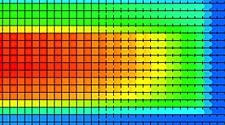
Knowledge of the maximum temperature reached at any point in the disposal system and the time period over which the temperature is predicted to exceed certain threshold values is an important input into a number of decisions regarding disposal concept selection and subsequent facility design. Quintessa has recently completed a study for the Nuclear Decommissioning Authority Radioactive Waste Management Directorate (NDA RWMD) that aimed to identify the key controls on the thermal performance of the High Level Waste / Spent Fuel (HLW/SF) disposal area of a UK Geological Disposal Facility (GDF) during the post-closure period, together with the important couplings to other processes that will need to be taken into account when evaluating the implications of disposing of wastes with different thermal loadings.
The work comprised an analysis of the processes that might be important for the transport of heat, followed by a stepwise programme of numerical modelling to quantify the impact of various processes and plausible ranges of system properties on the thermal evolution. The process analysis confirmed that the most significant couplings are likely to be between thermal and hydraulic processes. However the relative magnitudes of processes and couplings are highly case specific. Simple thermal conduction and radiation calculations that considered a range of disposal geometries (vertical, horizontal and cavern emplacement) and host rocks (higher strength, lower strength sedimentary and evaporite) demonstrated that the thermal density of the source term is the key control on the temperatures in the immediate vicinity of a waste package. This is determined by the combination of waste type, package loading, cooling time and package spacing. The choice of materials (host rock geology, buffer material, etc.) has a smaller influence if only thermal conduction and radiation are considered. Fully coupled thermal-hydraulic simulations however show that for some combinations of material properties, thermal-hydraulic coupling via the material properties can significantly influence thermal evolution. In cases where resaturation is not rapid and uniform the fully-coupled simulations show that the simple calculations may not be bounding in terms of the predicted peak temperature in the buffer. Peak temperatures in some of the coupled cases were a few degrees higher than in the equivalent uncoupled case.
This study has provided quantitative results that can be used to inform concept selection and has identified some of the factors that need to be taken into account when defining a GDF layout. The tools used in this study are available for use on specific examples, as has been illustrated by application to the NDA RWMD generic Disposal System Safety Case illustrative concepts. The simple conduction-radiation model has been benchmarked against a similar model developed by SKB. The study has also improved the understanding of the type of modelling that is likely to be appropriate for different concepts and geological environments and the likely approximations involved with adopting simpler approaches. The report (AE Bond and SP Watson, Understanding the Post-Closure Thermal Impact of HLW/SF Waste Packages: An NDA RWMD Research Study) is available from the NDA Radioactive Waste Management Bibliography.

Maximum temperature and time exceeding temperatures of 50 and 75°C for HLW base case in the vertical geometry. The information is displayed using a representation in which all compartments viewed as the same size; in the model compartment sizes range from millimetres to metres. The top left image indicating the distribution of material properties in the model. Note different scales for each plot to maximise visibility of information.
The model described in the published report has subsequently been developed to provide additional functionality required to support disposability assessments, and to provide a more flexible model suitable for NDA RWMD’s future requirements. These enhancements have removed a limitation in the original model that all waste packages had to be identical and emplaced at the same time, with the local model (for which the distribution of temperature in the waste package and buffer is calculated) at the centre of the facility. A range of different waste types can now be considered in a single model, the local model can be located anywhere within the facility and the waste packages can be emplaced at different times. This enhanced version is being used to support disposability assessments and disposal concept development for a range of high heat generating waste types.